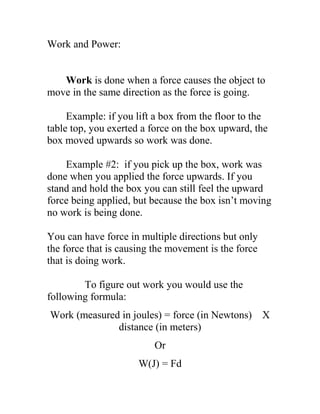Work and Power Explained: Force, Distance, Joules
•Download as DOC, PDF•
0 likes•425 views
Work is done when a force causes an object to move in the direction of the force. Work can be calculated using the formula Work = Force x Distance. Work is measured in joules, named after scientist James Joule. Power is a measure of how quickly work is done and is calculated by dividing work by time. Power is measured in watts, named after James Watt who helped advance steam engines.
Report
Share
Report
Share

Recommended
More Related Content
What's hot
What's hot (18)
Similar to Work and Power Explained: Force, Distance, Joules
Similar to Work and Power Explained: Force, Distance, Joules (20)
Work and energy. Practical Problems on Work and Energy

Work and energy. Practical Problems on Work and Energy
workenergypowerbyakshat-151106163627-lva1-app6892.pdf

workenergypowerbyakshat-151106163627-lva1-app6892.pdf
More from Pisgah High School
More from Pisgah High School (9)
Work and Power Explained: Force, Distance, Joules
- 1. Work and Power: Work is done when a force causes the object to move in the same direction as the force is going. Example: if you lift a box from the floor to the table top, you exerted a force on the box upward, the box moved upwards so work was done. Example #2: if you pick up the box, work was done when you applied the force upwards. If you stand and hold the box you can still feel the upward force being applied, but because the box isn’t moving no work is being done. You can have force in multiple directions but only the force that is causing the movement is the force that is doing work. To figure out work you would use the following formula: Work (measured in joules) = force (in Newtons) X distance (in meters) Or W(J) = Fd
- 2. Work is measured in joules named after James P. Joule a scientist who proved the law of conservation of energy Power is measured in Watts, named after James Watt the person who perfected the Steam Engine and laid the path for the industrial revolution. Power is how quickly work is done. To determine power you divide work by time Or P= W t